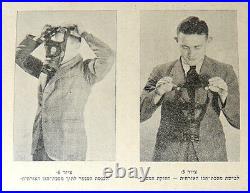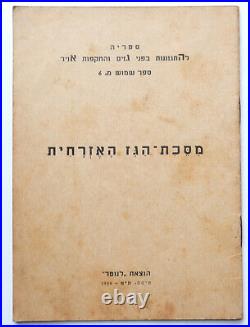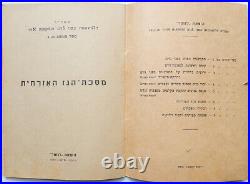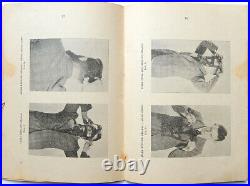






BRITISH CIVILIAN GAS MASK INSTRUCTION MANUAL WW2 PALESTINE 1939. This is an extremely rare instruction booklet how to use British Gas Mask. This manual was issued in Palestine in 1939, than under the brtish mandate. Printed by La’Noter publishing. Text is in Hebrew. This manual is the first edition, issued at the evening of WW2 to the Jewish population just before the war began to protect civilians from the effects of dreaded gas raids, respirators were issued to the entire population in the British empire. This manual includes photos and diagrams. Please have a look at my other listings. Gas played a major role in the First World War, meaning that in 1939 a lot of men carried the horrible memories of the horrors of a gas attack. Some were blinded by gas, while countless more suffered breathing difficulties throughout their lives. The terror of gas hung heavy on the public consciousness, and with the advent of the medium bomber bringing civilian population centres into the line of fire, the government considered the threat of gas to civilian populations to be severe. Bombings of urban centres from the air during the Spanish Civil War – such as the bombing of Guernica, immortalised in paint by Pablo Picasso – showed the dangers that bombers could present to civilians. The manufacture of these masks was no easy task – excluding the masks required for the armed services and those required for civilian services like the ARP and Fire Service, the government still needed to produce close to 38 million masks. The contract was given to a factory in Lancashire, and production started in earnest in 1938. The government still needed to produce close to 38 million masks. While the masks were being made, the government were training more and more members of the civil defence organisations in procedures for dealing with gas casualties. Air Raid Wardens would carry old football rattles to sound in the event of gas being detected or suspected. Some local swimming baths had their separated male and female changing rooms commandeered for decontamination facilities. Householders were advised to tape their windows shut as an anti-gas sealant measure, while post and telephone boxes were painted with red paint that would turn green on exposure to gas. Private firms started to manufacture gas masks for dogs and horses for sale to families who wanted them. Attempts were made to manufacture less intimidating masks for children and babies. Post and telephone boxes were painted with red paint that would turn green on exposure to gas With 1939 and the outbreak of war, these masks were issued to the public in cardboard boxes with strict instructions that they be carried at all times, without exception. Fines would be imposed if you were caught without your respirator. As such, many people replaced their cardboard boxes in time with privately available alternatives, as the government-issue cardboard boxes were prone to falling apart and were cumbersome. Despite the government’s diligent planning, gas was never used against British civilians. Hey were issued in a cardboard box, which gave details of mask size (small, normal or large) embossed on the lid. The box contained the mask, a carry bag and de-misting kit (the small green tube shown in the image with the mask and bag). The bags were of a variety of colours, although the canvas type shown here was the more common; along with a green hessian type later in the war. The exhaled breath was released by means of the’flutter’ valve on the front of the mask, between the eye-pieces and above the filter. The green filter extension on the front provided protection against more gas types than the mask was originally designed for. They were prone to misting up as well as the weight of the filter causing the mask to slip down when worn for extended periods. Recently, it has been made known that the filters of WW2 gas masks contain asbestos; because of this you should NEVER wear a mask and consult a professional for SAFE DISPOSAL in the event of the mask becoming damaged. The British civilian service gas mask was not issued to the general public, but to the Civilian Defence and other official bodies (for example, the police). They used the same filter as on the standard civilian-issue mask, but were of a different design and produced to a higher standard. Unlike the cheaper civilian-issue type, each part could be replaced in the event of damage. Another feature was the existence of a’stub’ on the left hand side of the mask, which allowed for the easy conversion to accept a microphone for use with telephones. ARP General Service Respirator (GSR) and Haversack Carry Bag The General Service Respirator (GSR) featured a hose connected to the filter and provided more facial coverage. It was designed to allow the wearer to withstand heavy concentrations of gas for long periods, and to give the wearer the greatest possible freedom of movement and comfort. When worn the haversack was worn high on the chest and was connected to the facepiece via a corrugated rubber tube. The eyepieces were made of unsplinterable glass, and there was a special outlet valve designed to allow audibility of speech. Civilian Duty Respirator & Shoulder Bag Civilian Duty Respirator gas masks were issued to all members of the Civil Defence services not issued the respirator above. The facepiece was made of noulded rubber thicker than the Civilian Duty Respirator covered below. It was fitted with an outlet valve and with removable eyepieces of strong glass held in metal rims. The carrying bag was a simple cloth bag with shoulder strap – many variations in design exist. The respirator protected the wearer from all known war gases. WW2 Civilian Duty Respirator Gas Mask Carrier This simple sack was used to carry the Civilian Duty Respirator. The bag was closed with a flap and two buttons. The white cotton shoulder strap was siupllied with a section that had been sewn so that by undoing a section the length of the strap could be increased. General Civilian Respirator This was the type of gas mask issued to the general public (adults and children aged over four) prior and during the second world war. The facepiece is made of thin sheet rubber, with a window of non-flammable transparent material. Air is drawn through the container, and exhaled air is prevented from passing back through the same channel by a simple non-return valve consisting of a rubber disc attached to the inner end of the container. He exhaled air forces its way out by lifting the thin rubber of the facepiece at its edges, so that a separate outlet valve is unnecessary. Canister & Spare Filters. This item is in the category “Collectibles\Religion & Spirituality\Judaism\Books”. The seller is “levant-fair” and is located in this country: IL.
- Country/Region of Manufacture: Israel
- Religion: Judaism

